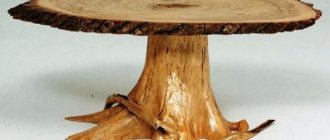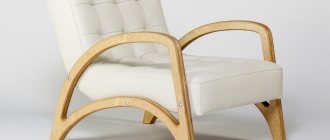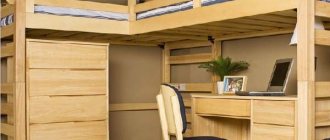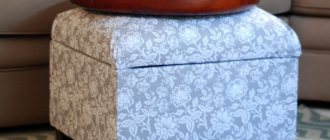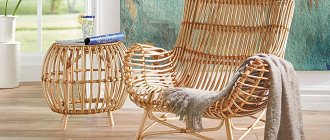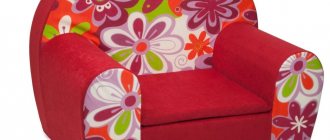The modern furniture market offers a huge range of products for offices and homes. However, some home craftsmen prefer to make them themselves, at least such simple structures as cabinets, shelves, tables and chairs. And today we will talk about how to make with your own hands a rather simple and, at the same time, very necessary element of any kitchen furniture - a plywood stool.
Main details of the stool
This primitive piece of furniture has only two main elements - legs and a seat. No backs or unnecessary accessories. More complex designs have reinforcements - legs at the bottom and drawers at the top. That's all the terms, now you can start describing the sizes. After all, when making furniture, you need to decide on the size first. If you don't have any ideas, look at the options for finished products.
The next stage is the development of the scheme. Measure the height and other parameters of the stool. Optimal sizes:
- The seat for an adult should have a size of 30-45 cm.
- For children – 25-28 cm.
It is worth noting one feature of homemade stools - they should be much more comfortable than standard ones. After all, during production you can adjust all the sizes exactly to yourself. Draw up a drawing yourself so that when making a stool it will be before your eyes.
What should you pay attention to when choosing a future stool model?
- Form. It must match the design of the table. For example, round chairs will not fit well with a square or rectangular table.
- Upholstery type. Since the plywood stool will undergo intensive use, it is better to choose materials that do not require special care. Choose washable options such as eco-leather or short pile fabrics.
- Chair dimensions. For ease of use and storage of stools, their height and seat dimensions should allow placement under the table.
Materials for production
When manufacturing, you need to use quality materials. The most reliable are forged products. But they are expensive and working with metal is more difficult. Wood is a fairly reliable material, as it is durable and easy to work with. But be sure to dry the wood at a temperature of 20-30 degrees before starting work. Drying wood in a chamber causes it to begin to crack.
Hardwoods perform well - birch, maple, hemlock, wenge. Another option is to make at least the legs out of wood. After all, these elements take on a huge load. The requirements for the seat are not so stringent, so it is possible to use plywood or chipboard. A stool made of birch plywood will be reliable, and the material is easy to work with.
Features of materials
The cheapest option is chipboard. It is worth noting that this material is not reliable. True, the slabs can be strengthened to reduce the pressure on them. But it is unlikely that you will be able to get rid of the second drawback - the formaldehyde resins contained in chipboards are constantly released into the surrounding space. And there is no way to completely get rid of them.
MDF board is much stronger. And most importantly, it is durable. But it is best combined with hardwood. As a rule, MDF is used only for making seats. An excellent substitute for wood is plywood. This is a durable and environmentally friendly material; all structural parts can be made from it. You can literally make a simple stool from just 3-4 plywood elements.
Preparing the necessary tools
To make a wooden product you will need the following carpentry tools:
- a manual router, complemented by a set of cutters that allow you to process the edges of timber, boards and plywood, drill holes of the required size, or carefully select grooves and grooves on parts;
- a grinding machine equipped with interchangeable wheels of different grain sizes, which allows you to quickly make the wood surface smooth;
- an electric jigsaw, which can be replaced with a manual hacksaw, although with a decrease in efficiency;
- a screwdriver used for screwing in fasteners and drilling holes in parts, for which a set of drills and screwdriver bits of different diameters is useful;
- clamps of different sizes, designed for strong compression of parts during gluing;
- hammer;
- chisels of various sizes;
- plane, manual or electric;
- marking and measuring equipment - construction square, tape measure, simple pencil, surface planer, etc.;
- durable workbench.
To make a stool you will need tools.
Manufacturing procedure
So, it's time to start making the stool. Prepare a sheet of plywood, blocks of wood (if you decide to make the legs from natural material). If you do not have the opportunity to purchase an electric jigsaw, you can use a manual one. As an option, buy a thin blade for a hacksaw for metal. With its help, you can easily cut a piece of any shape from plywood.
First of all, you need to cut out patterns from paper. These are templates for all parts made of paper or cardboard. They must exactly follow the contours of all elements. However, if you have a good imagination and eye, then you don’t have to make templates.
So, let's start making all the parts:
- First we prepare the legs with a square section of 50x50 mm. To do this, you need to saw off 4 identical pieces of 450 mm each from a whole block.
- Now cut out a blank from plywood for the seat - size approximately 380x380 mm. It is advisable to use boards 20 mm thick.
- Now you need to cut out the drawers and legs to connect the legs. In total you will need 4 elements.
- You will also need 4 bars to connect the seat and drawers. To do this, you need to cut tenons on the edges of the drawers, and grooves on the legs. The length of the grooves and tenons should be 20-25 mm. The same thing needs to be done with the legs.
Scheme and drawing
Many stool furniture manufacturers apply the following standards:
- Height – 450 mm
- Seat – 300×300 mm
Tip : These sizes can be reduced or increased if the product is intended for a specific person and you want to provide him with maximum comfort.
Let's look at creating a sketch using the example below.
We mark out the parts of the future stool and start with the leg, as the most complex element:
- Draw a rectangle according to its dimensions on a sheet of plywood.
- We connect the middles of the long sides with a line.
- We retreat the same distance to the right and left of them and make marks on the middle line.
- We connect these points with the vertices of the rectangle.
- We select any round object (cup, saucer), combine it with the lines at the intersection and connect it with an arc.
We continue to draw the outline of the H-shaped leg with straight lines and round off their connection with each other with objects of suitable diameter.
Completion of production
All wood elements must be sanded. Initial assembly should be carried out without glue. If necessary, you need to adjust the elements. Finally, lubricate the parts with wood glue and assemble them into a single structure. The bars located between the frames must be secured with screws to the bottom of the seat. If you wish, you can make the seat soft. To do this, you will have to buy fabric and foam rubber (the piece should have the same dimensions as the seat). Fixing the upholstery fabric should be done using a stapler.
Methods for attaching parts to each other
To make a simple stool, several types of fastening parts are used:
| Connection using corners. | It is optimal if the width of the material from which the drawer will be made is 5-7 cm; this element will be fixed under the seat. The metal corner will not be visible, so it will not spoil the appearance of the structure. To attach the legs, it is better to turn the seat over. Those pieces of plywood that will give rigidity to the product must be inserted between the legs so that their outer edges form a single plane. Short clamps are used to secure them. No self-tapping screw should be screwed all the way through. |
| Fixation with screws. | In this case, the slats are screwed to the top of the legs using hardware. |
| Fastening with glue. | This method is optional. It is better to use it in conjunction with screws or self-tapping screws. |
Which method of fixing the plywood will be chosen depends on the design of the stool.
Other types of stools
There are designs that are much easier to make than classic ones. The most common are structures consisting of a seat, two wide legs and a jumper. The assembly of such a stool can be made from wood, chipboard, MDF, plywood.
The structure is fastened using furniture screws and wood glue. Please note that the crossbar should be trapezoidal and have a bevel of about 5 mm. In this case, the stool will be as stable as possible.
There is also a lightweight version - without drawers. In this case, the legs are placed directly into the grooves on the seat. One point should be noted - the seat will have to be made of thick plywood. You can attach bars to the places where they are attached to the seat, in which the grooves are made. The legs should be slightly thicker than in the case of using drawers.
You can make another simple plywood stool design with your own hands. Photos of such structures are given in our article. You need to make two legs from plywood, they need to be positioned at an angle of 90 degrees. A seat is fixed on top of them. Afterwards, you can carefully sand all the elements of the stool and treat it with paint and varnish.
How to determine the optimal dimensions
The main dimensions of furniture are chosen in accordance with the average anthropometric data of an adult. Functional dimensions are designed for an average height of 175 cm. Parameters for children are calculated depending on height.
The correct bending angle of the knees when sitting should be at least 90 degrees, while the feet should be fully on the floor.
To make a stool with your own hands, you need to take into account only two dimensions: the height from the floor and the width of the seat. Ideally, the height of the seat should reach the knees of a standing person. The full height of the chair is calculated depending on the dimensions of the kitchen table. If it provides a level of 680-750 mm, then the comfortable height of the stool will vary from 420 to 450 mm. With a kitchen countertop height of 680 mm, the stool’s parameters will increase to approximately 650 mm. For the size of stepladders, the height of wall-mounted kitchen furniture is taken into account. With the average height of the housewife (158-160 cm), it is 450-650 mm. Comfortable seat width – at least 360 mm. The design of the stool requires a strict balance between the height, width of the seat and the shape of the lower part. Failure to comply with these parameters will result in poor stability of the product, falling and injury.
Stool decoration
And the final stage is registration. It directly depends on the room in which it will be used. You can take a stencil to apply a design to the surface. The most convenient way to do this is to use an aerosol can. Of course, be sure to apply varnish on top.
Another option is to make decoupage. This is a complex process, but it is quite possible to do it yourself. To do this, you will need PVA glue, napkins with a beautiful pattern, and acrylic varnish. If you don’t want to spend a lot of time on decoration, just decorate one seat. And for inspiration, look at the photo of plywood stools.
